
Below is a list of trees that symbolise Venezuela and each state of the country:

Below is a list of trees that symbolise Venezuela and each state of the country:
The National Tree of Venezuela is the Araguaney ( Handroanthus chrysanthus ).
| State | Local name | Binomial name |
|---|---|---|
| Amazonas | Caucho | Hevea benthamiana |
| Anzoátegui | Cereipo, or Guatamare | Myrospermum frutescens |
| Apure | Merecure | Moquilea pyrifolia |
| Aragua | Samán | Albizia saman |
| Barinas | Cedro | Cedrela odorata |
| Bolívar | Sarrapia | Dipteryx odorata |
| Carabobo | Camoruco | Sterculia apetala |
| Cojedes | Apamate | Tabebuia rosea |
| Delta Amacuro | Mangle rojo | Rhizophora mangle |
| Falcón | Cují Yaque | Prosopis juliflora |
| Guárico | Palma Llanera | Copernicia tectorum |
| Lara | Semeruco | Malpighia glabra |
| Mérida | Bucare ceibo | Erythrina poeppigiana |
| Miranda | Roso Blanco | Brownea leucantha |
| Monagas | Palma de Moriche | Mauritia flexuosa |
| Nueva Esparta | Guayacán | Guaiacum officinale |
| Portuguesa | Caoba | Swietenia macrophylla |
| Sucre | Roble | Platymiscium diadelphum |
| Táchira | Pino criollo, or Pino laso | Prumnopitys montana |
| Trujillo | Bucare anauco, or Reinoso | Erythrina fusca |
| Vargas | Uva de Playa | Coccoloba uvifera |
| Yaracuy | Chaguaramo | Roystonea oleracea |
| Zulia | Cocotero | Cocos nucifera |
July is the seventh month of the year in the Julian and Gregorian calendars. Its length is 31 days. It was named by the Roman Senate in honour of Roman general Julius Caesar in 44 B.C., being the month of his birth. Before then it was called Quintilis, being the fifth month of the calendar that started with March.
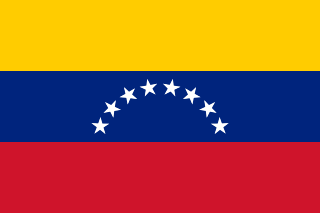
Venezuela, officially the Bolivarian Republic of Venezuela, is a country on the northern coast of South America, consisting of a continental landmass and many islands and islets in the Caribbean Sea. Venezuela comprises an area of 916,445 km2 (353,841 sq mi), and its population was estimated at 29 million in 2022. The capital and largest urban agglomeration is the city of Caracas.
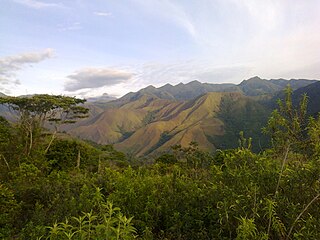
Zulia State is one of the 23 states of Venezuela. The state capital is Maracaibo. As of the 2011 census, it has a population of 3,704,404, the largest population among Venezuela's states. It is also one of the few states in Venezuela in which voseo is widespread. The state is coterminous with the eponymous region of Zulia.

Anzoátegui State is one of the 23 states of Venezuela, located in the northeastern region of the country. Anzoátegui is well known for its beaches that attract many visitors. Its coast consists of a single beach approximately 100 km (62 mi) long. Its capital is the city of Barcelona, and significant cities include Puerto la Cruz and El Tigre.

Arauca is a department of Eastern Colombia located in the extreme north of the Orinoco Basin of Colombia, bordering Venezuela. The southern boundary of Arauca is formed by the Casanare and Meta Rivers, separating Arauca from the departments of Casanare and Vichada. To the west, Arauca borders the department of Boyacá. The Caño Limón oil fields located within Arauca account for almost a third of the Colombian oil output. Its capital is the town of Arauca.

Miranda State is one of the 23 states of Venezuela and the second most populous after Zulia State. As of the 2011 census, it had a population of 2,675,165 residents. It also has the greatest Human Development Index in Venezuela, according to the Venezuelan National Institute of Statistics. The most recent population estimate was 3,194,390 in mid-2016.

The Sucre State is one of the 23 states of Venezuela. The state capital is Cumaná city. Sucre State covers a total surface area of 11,800 km2 (4,600 sq mi) and, as of the 2011 census, had a population of 896,921. The most important river in the state is the Manzanares River.

Cúcuta, officially San José de Cúcuta, is a Colombian municipality, capital of the department of Norte de Santander and nucleus of the Metropolitan Area of Cúcuta. The city is located in the homonymous valley, at the foot of the Eastern Ranges of the Colombian Andes, on the border with Venezuela. It comprises an area of approximately 1119 km2, with an urban area of 64 km2 and a rural area of 1055 km2. The city has a population of 777,106 inhabitants, which makes it the most populous municipality in the department and the sixth most populous municipality in the country. Similarly, its metropolitan area has an approximate population of 1,046,347.

The Pemon or Pemón (Pemong) are indigenous people living in areas of Venezuela, Brazil, and Guyana. The Pemon people are divided into many dialects and traditions, which are Arekuna, Kamarakoto, and Taurepang.

The Venezuela national football team, nicknamed La Tricolor Venezolana, represents Venezuela in men's international football and is controlled by the Venezuelan Football Federation (FVF), the governing body for football in Venezuela. Their nickname is a reference to the unique “red wine” team color that is used on their home jerseys. When playing at home in official games, they usually rotate between three stadiums: The Polideportivo Cachamay in Puerto Ordaz, the Estadio José Antonio Anzoátegui in Puerto La Cruz and the Estadio Pueblo Nuevo in San Cristóbal. In friendly matches, they tend to rotate between the rest of the stadiums in the country.
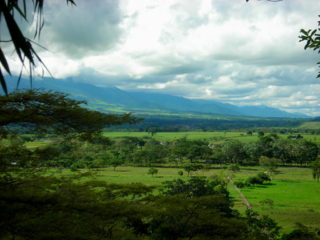
The Llanos is a vast tropical grassland plain situated to the east of the Andes in Colombia and Venezuela, in northwestern South America. It is an ecoregion of the tropical and subtropical grasslands, savannas, and shrublands biome.
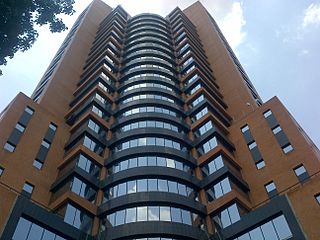
Maracay is a city in north-central Venezuela, near the Caribbean coast, and is the capital and most important city of the state of Aragua. Most of it falls under the jurisdiction of Girardot Municipality. The population of Maracay and its surroundings in the 2011 census was 955,362. In Venezuela, Maracay is known as "Ciudad Jardín".
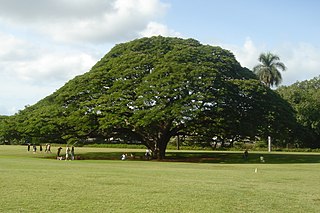
Samanea saman is a species of flowering tree in the pea family, Fabaceae, now in the Mimosoid clade and is native to Central and South America. It is often placed in the genus Samanea, which by yet other authors is subsumed in Albizia entirely.
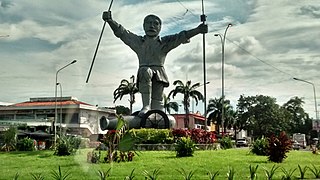
Acarigua, founded as San Miguel de Acarigua, is a city in northwestern Venezuela, in the northern part of the state of Portuguesa.
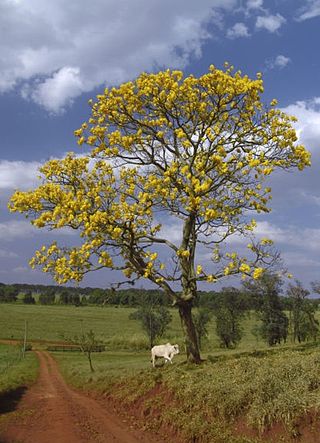
The flora of Venezuela consists of a huge variety of unique plants; around 38% of the estimated 30,000 species of plants found in the country are endemic to Venezuela. Overall, around 48% of Venezuela's land is forested; this includes over 60% of the Venezuelan Amazon. These rainforests are increasingly endangered by mining and logging activities.

The national symbols of Venezuela are the flag, the coat of arms, and the national anthem. Since Venezuela's diversity of flora and fauna is remarkable, the government also officially declared these national symbols:
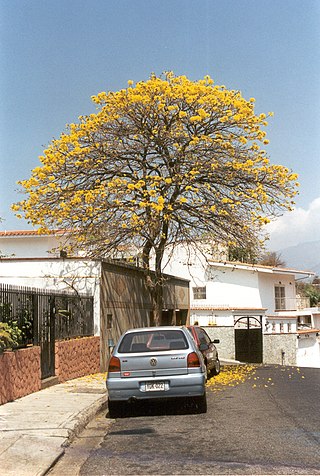
Handroanthus chrysanthus, formerly classified as Tabebuia chrysantha, also known as araguaney in Venezuela, as guayacán in Colombia and Panama, as chonta quiru in Peru, and Ecuador, as tajibo in Bolivia, and as ipê-amarelo in Brazil, is a native tree of the intertropical broadleaf deciduous forests of South America above the Tropic of Capricorn. On May 29, 1948, Handroanthus chrysanthus was declared the National Tree of Venezuela due to its status as an emblematic native species of extraordinary beauty. Its deep yellow resembles that of the Venezuelan flag.
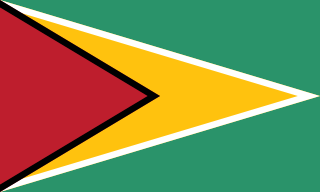
Guyana, officially the Co-operative Republic of Guyana, is a country on the northern coast of South America, part of the historic mainland British West Indies. Guyana is an indigenous word which means "Land of Many Waters". Georgetown is the capital of Guyana and is also the country's largest city. Guyana is bordered by the Atlantic Ocean to the north, Brazil to the south and southwest, Venezuela to the west, and Suriname to the east. With a land area of 214,969 km2 (83,000 sq mi), Guyana is the third-smallest sovereign state by area in mainland South America after Uruguay and Suriname, and is the second-least populous sovereign state in South America after Suriname; it is also one of the least densely populated countries on Earth. The official language of the country is English, although a large part of the population is bilingual in English and the indigenous languages. It has a wide variety of natural habitats and very high biodiversity. The country also hosts a part of the Amazon rainforest, the largest tropical rainforest in the world.
Meruidae is a family of aquatic beetles in the suborder Adephaga, with only one genus and species, Meru phyllisae. The beetle species was first found in the early 1980s. and fully described in 2005. At 0.8 mm (0.031 in), it is one of the smallest adephagan beetles in the world. A survey of aquatic beetles of Venezuela indicated that Meru is most common during the wet season, when larger areas of granitic rock surface are covered with water film, which the adult beetles as well as the larvae inhabit.

The Caobos Park is one of the oldest parks of Caracas, Venezuela. Located near the Museum of Fine Arts, the Science Museum, the National Art Gallery, the National Experimental University of the Arts, the Teresa Carreño Cultural Complex and the Boulevard Amador Bendayan.